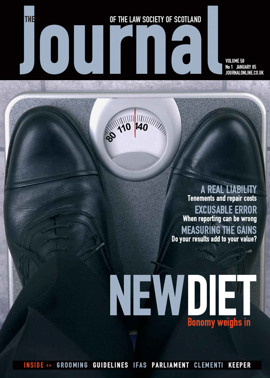Last stand for the defence
In 1987 the Scottish Legal Aid Board was created. In the space of 17 years, in my opinion, its sphere of influence has expanded as that of the Society has diminished. Many practitioners believe the Society has been relegated to helpless bystander as SLAB rings the changes. A solicitor providing criminal legal aid must now be registered with SLAB, which retains the right to deregister. SLAB has to approve policy documents; carries out inspections and audits; and is introducing peer reviews. In short, SLAB controls day-to-day regulation. It has a statutory obligation to regulate public expenditure; this led to the recent publication of all funds paid to civil and criminal practitioners. Fair enough – it is after all public money. Given that the fees paid to criminal practitioners (excluding VAT and outlays) amount to about 4p per day per head of the population, it serves to highlight the incredible value for money we provide.
However to many people the Society is now perceived as irrelevant to the day-to-day running of a practice. It is seemingly unable to secure any meaningful benefits for its criminal court members and apparently inept at getting practitioners’ views across to the powers that be.
I have served on Council. I know from experience this is simply not true. Many dedicated practitioners have tried to represent our interests in discussions with the Executive and SLAB. Often their efforts led to the worst excesses of proposed reforms being abandoned. The truth however was that the Society’s submissions often went unheeded – viewed, ironically, by those implementing changes as founded in self-interest, but by its members as wholly inadequate to protect those interests.
Whether the Society recovers its standing may depend on how it tackles a new problem. Who will provide criminal legal assistance in the 21st century?
Traditionally the training process was part of an equation. Raw trainees were taken on by firms, trained, and dispatched into private practice fully qualified. In return firms were remunerated for the trainee’s work and gained an economic advantage.
The cycle was broken with the introduction of fixed fees for summary work. Immediately the first year trainee’s ability to earn his employers any remuneration in this field was vastly diminished. When solemn fixed fees arrive in 2005-06 that capacity will almost totally disappear – apart from the £5.25 per quarter hour for instructing counsel in the High Court! And we now have to release our trainees for the Society’s professional exams.
As a result there are few criminal trainees around. Who can stand the costs of employing them? I believe only a “not for profit” or government agency, such as the Public Defence Solicitor’s Office.
There are anecdotal stories that the PDSO costs more to run than a comparable private practice. I do not know the truth of that, but I do know that in reality the government will meet any shortfall. The PDSO recently advertised for a trainee. In five years its Edinburgh office has become one of the city’s biggest firms. There are now three offices across Scotland. If they employ one trainee per year between now and 2008 (the next review year), they will have 10-15 trainees. Assume by 2008, seven offices each employing two trainees per year. This equates to a considerable training programme, irrespective of other employed solicitors. It is quite possible that by around 2018 the PDSO, in size, will almost mirror the fiscal service.
Sound far fetched? The average age of the criminal practitioner in Glasgow is about 42. On current trends, by 2014 it will be in the 50s. I suspect that by 2013 there may be more PDSO solicitors than private practitioners. If it is then enacted that from 2020 the PDSO shall provide all publicly funded criminal legal assistance, the job is done. No need for radical reform. Passage of time will do the job. The PDSO can take over the remaining private practitioners in 2020 until they retire.
If my assumptions have any merit, the acid test for policymakers must be, how will today’s private practitioner react? The answer is probably with indifference. We are used to there being no trainees; and getting used to fewer assistants. We long ago gave up on any meaningful remuneration increase. I believe there is a general consensus of “Que sera, sera”.
Most of us are looking warily at the High Court reforms. Many stare with disbelief at the greatly increased administrative burden to be imposed on us – even before the Vulnerable Witnesses Act. I do not know any practitioner who believes that we, and the fiscal’s department, will not be stretched beyond resources to comply. However we know that government will provide for the latter.
Most practitioners have a hard enough job looking to 2005 without worrying about the medium-long term future of the profession as currently constituted. That is the real challenge for the Society to meet. Let us hope it meets it head on.
In this issue
- Riding the wave of change
- Last stand for the defence
- Losing the wait
- What right to be wrong?
- Prevention as the cure
- No room for half measures
- Poles apart
- Get IT right
- The value proposition
- A time for resolution
- When it falls, it falls
- Round the houses
- Private bills and public interest
- Charging Peter to pay Paul
- Fair pay for liquidators
- Website reviews
- Book reviews
- Fair notice?
- The new title conditions






